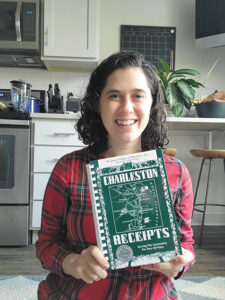 By Laura Donnellon
By Laura Donnellon A few years ago for Christmas, my father gifted me a cookbook called Charleston Receipts, which is one of the more famous and historic cookbooks in the south. The book was first published in 1950 by the Junior League of Charleston and is now one of the Junior League’s oldest cookbooks that is still in print.
What makes this cookbook so unique is that it is not only full of recipes that were the foundations for much southern food consumed today, but it is also full of Gullah verses and sketches by local Charleston artists. The Cookbook contains 750 recipes, Gullah verses, and sketches to be exact.
It took the Junior League committee one month to collect the recipes from Charleston residents, two months to test the recipes and four months to compile the book together. So far, over 750,000 copies of the book have been sold and the copy that I own is their 13th printing. The book has won special awards for preserving American local and regional culinary customs, while having a strong and positive impact on the community.
You may now be wondering what exactly the term “Gullah” is. Gullah is an English-based creole language that was created by enslaved African Americans working on rice plantations in the south. Many people, more specifically in the lowcountry regions of South Carolina and some areas of Georgia still speak the Gullah language today and also maintain many of their cooking and unique crafting traditions.
This cookbook is so special and highly sought after by antique collectors because it celebrates the connection of the culinary practices of the elite southern aristocracy to the Gullah people.
I have found this cookbook to be very influential because it has led me to become more adventurous in my cooking, as well as what I order if I go out to eat. Before moving to Charleston, I couldn’t stand the taste of fish and now I absolutely love it. The Gullah people were the real experts of the southern culinary world and I am so thankful that their traditions have continued to thrive and inspire the culinary industry in the south that exists today.
If you’d like to purchase your very own copy of the Charleston Receipts cookbook, you can do so by placing an order through the Historic Charleston Foundation’s website (https://www. historiccharleston.org/store/charleston-receipts.html), as well as through many generic book-ordering websites, such as Amazon.
Miss Donnellon also has developed a website about Charleston food that you might want to explore. Go to www.chsfoodiesona budget.com to check out this amazing website.
Example Recipe from the Charleston Receipts Cookbook:
James Island Shrimp Pie
This receipt came originally from Mrs. Robert Lebby, Sr. of James Island, about 1860. Ingredients 1 cup of raw rice 2 cups water 1 teaspoon salt 1/4 cup butter 2 eggs Pinch of mace 5 tablespoons tomato catsup [ketchup] 2.5 tablespoons Worcestershire Salt and pepper to taste 2 pounds shrimp 1 cup milk (approximately) Instructions Cook rice in salted water until very soft and stir butter into it. Combine all ingredients with cooked shrimp, adding enough milk to make mixture the consistency of thick custard. Put in buttered casserole and bake in oven at 325 degrees until brown on top (about 30 minutes). Serves eight.















Follow Us